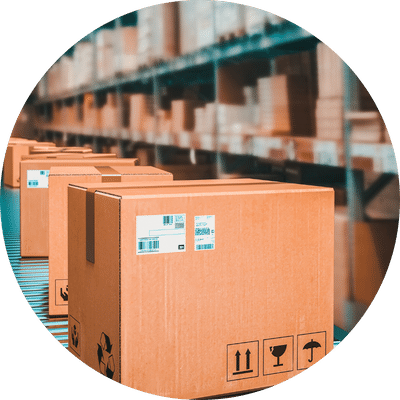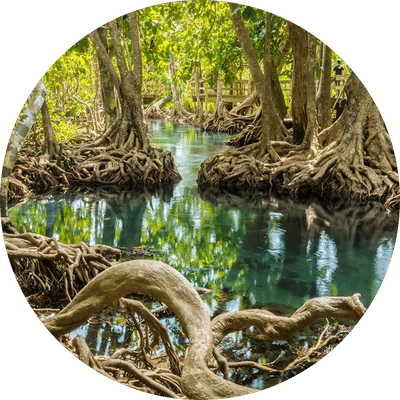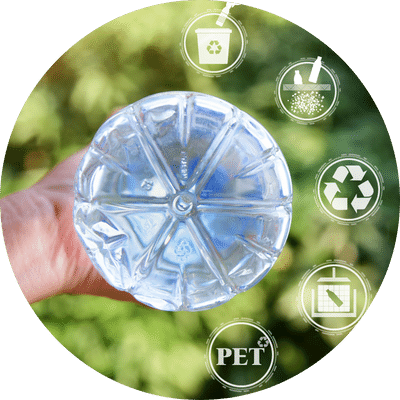Frequently asked questions
and answers
Questions about Kuwi.org
Kuwi.org is a recognized non-profit organization based in Amsterdam.
We consistently invest 80% of every euro directly into climate projects. The remaining 20% is allocated for overhead costs. Any surplus within that 20% is earmarked for our sustainability reserve.
For more information about our financial roadmap and objectives, you can have a look at our annual reports.
Numerous studies indicate that supporting climate projects and offsetting CO₂ play a significant role in reversing climate change.
After industrialization, deforestation is the leading cause of climate change. While industrialization increased CO₂ levels in our atmosphere, deforestation reduces CO₂ absorption; the combination of these factors has severely damaged the climate and ecosystems globally.
Since our inception in 2017, we remain a small organization and only a small part of the growing movement of millions of people concerned about climate change. We believe our organization primarily facilitates individuals and businesses committed to making a difference. People like you, and the businesses that support us, have together planted over a million trees and captured over 900,000 tons of CO₂. We gauge our impact by how we allocate funds, and we consider it our core duty to do so as efficiently as possible.
For those reading this, we expect them to be above-average concerned about their ecological footprint. Unfortunately, this is not the case for many people. The average CO₂ emissions per person vary greatly, from 2 tons per year for the environmentally conscious among us to 30 tons for the least conscious. For example, the average CO₂ emissions per person in the UK (5.5 tons) are three times lower than in the United States, with 15.5 tons per person.
Based on the above facts, we can conclude that planting trees is only part of the solution. Small adjustments in your life can make a huge difference. It’s true, that spending a few minutes less in the shower can make a significant impact; check out our article “Small Changes with a Big Impact” for more information.
The collective impact to which you contribute is verifiable through our reporting and compliance ledger. We uphold high standards for our reforestation partners and take responsibility and accountability for their performance. We request a comprehensive project plan using a standardized template and require regular third-party audits. We assume responsibility for the entire tree planting project from inception to long-term maintenance.
To ensure long-term success, we strive to work year after year with the same organizations. Through our internal playbook based on ISO 9001 and ISO 19011, we keep the team vigilant about the pitfalls associated with long-term relationships and also shoulder responsibility for the long term.
For CO₂ offsetting, we only purchase credits that adhere to the leading CO₂ standards, namely the Gold Standard and Verified Carbon Standard. We maintain an open-book policy and an open-door policy, so whether you’re from the press, a customer, a supplier, or simply a curious individual, you can always reach out to us for compliance-related queries via admin@kuwi.org.
Questions about trees
A key question that requires a detailed answer. We take responsibility and ownership in our selection of planting partners. The project tender phase is only accessible for renowned organisations, and we require a well written, tailored and comprehensive plan to ensure the funds are spent as effectively as possible. Aftercare forms an important element of the plan for partner selection.
It’s critical to understand that it isn’t always objective to let trees run their full lifecycle. Most of the CO2 that trees capture is caught in their growth phase, when a tree is in the last phase of its lifecycle it’s sensible to use its natural resources. Think of sustainable (for example FCS) wood for furniture or paper. It is however essential to replace the tree.
Not replacing trees used for resources, or cutting down trees that are still productive and/or delivering forestry products are the cause of mass deforestation; not the phenomenon of humans using wood for crafts and construction. If you’re interested, please read our full article about responsible forest management here.
NOTE: The above-mentioned only applies to specific planting projects like agroforestry. This does not apply to planting projects for the purpose of restoring primary forests and rainforests, nor for planting projects that involve the restoration of animal habitats. At Kuwi.org almost all projects fall under the latter mentioned as we feel that restoring the damage caused by over two centuries of industrial mass deforestation has priority.
The best solutions for sustainable forest management are:
Working together with the (local) government to ensure desired reforestation projects benefit all stakeholders. In most cases, the government appoints national parks and other protected areas for reforestation projects. Especially in Asia governments have made big steps in understanding the catastrophic effect that mass deforestation had on their ecosystems. The national parks often have very rare and threatened species which the government is eager to protect in perpetuity.
Working with the local communities and hiring local villagers to plant the trees. This way there is an incentive for villagers to protect their work to ensure the continuity for future reforestation projects. We love this approach as the knife cuts both ways as it fights poverty whiles enabling financially feasible planting projects. We also take responsibility and ownership in preventing modern slavery, as can be read in our statement against modern slavery.
In addition to the above-mentioned is education. We have noticed that the local communities are thriving under the employment and cohesion that planting trees bring. They notice the effect of restoring the ecosystem; increase in fisheries, better farming, cleaner water and less vermin. When conditions are improving, they feel ownership and enthusiasm to protect their forest.
Planting agroforestry species i.e. fruit, construction, and fodder. These species form a recurring source of income and supply the needs of humans and animals in the local communities. As explained before, these trees can be used for raw materials if they are replaced.
Providing alternative sources of fuel. Mainly in African countries, wood is still the main source of fuel. By providing fuel-efficient dry wood stoves and other alternative sources of energy, the need for charcoal and wood is reduced or eliminated.
Hiring forest guards as part of their workforce. Especially the bigger planting partners have those for each project.
All organisations we work with have delivered a plan that is approved by us and measure up to the requirements. One of which is independent and regular auditing, we closely monitor all auditing reports internally.
This aspect is also incorporated in our template for project tenders. The planting projects we fund are audited by third parties. We study and assess those regularly, please shoot us an email if you wish to receive one or several of these reports.
If you’ve purchased a tree as an individual for a planting project in Europe, we’ll send you the exact location.
Yes, man-made homogeneous forests do not contribute to the restoration of ecosystems and do not fall under the scope of responsible reforestation. Each project we fund starts with an analysis to map out the native species of the forest and what is required to restore a balanced ecosystem. Projects always contain dozens of species planted over a multi-year plan. One exemption to this is reforestation projects in Nordic climates near the Arctic, in this climate monoculture forests are natural.
To date, we mainly plant fast-growing species. For CO2 capturing purposes, fast-growing species are vital in reforesting the globe quickly, efficiently and impactfully. Since cost is an ever deciding factor, we aim to maximise impact for the budget we have.
Kuwi.org is quite a young organisation (2017) but we are more than a reforestation organisation. We care for ecosystems as a whole, so planting a wider variety of species is one of our top priorities. The wider the variety of trees, the bigger our supply chain gets, therefore we must work towards goals at a healthy rate to ensure the wellbeing and continuity of our organisation. In the future, we aim to start up more projects specifically focused on restoring animal habitats.
The plantation of rare and endangered species is by no means easy. It involves a different set of knowledge and operations. These trees often need to be planted individually within ecosystems under specific conditions. This makes it up to 25 times more expensive than planting fast-growing species.
In short, the 80-20 rule also exists within these projects. For the most part, it is relatively easy to plant the dominant species within the ecosystem, and then comes the complex part of restoring the forest to its original state by planting specific species.
For this, we look at two aspects; the initial survival rate and the reproduction of the survived trees (natural regeneration). The latter varies wildly per species, as some are considered asexual while others can have both male and female flowers. In addition, there are climate and wildlife variations that determine the presence of pollinators like wind, insects, and birds.
The initial survival rate exceeds 80%. Various studies have rated the combination of the initial survival rate and natural regeneration somewhere between 150% and 500% depending on the variety of factors mentioned.
This differs wildly per species. For each tree, we plant, you can find this on the info page of the specific species. It’s important to not stare blindly at these numbers, as other factors play a role, like the natural regeneration rate (reproduction rate of a tree).
For example, Mangroves are relatively cheap to plant, reproduce quickly and take up around 300 kg of CO2 in their growth phase. On the other hand, some species take up 800 kg of CO2 in their growth phase, but the natural regeneration rate is far lower and the planting is more expensive.
Either way, reforestation is one of the best tools to capture carbon pollution from our atmosphere. Trees don’t need electricity or maintenance to function and offer a wide array of additional benefits like fruits, shade durable wood products like FSC-certified paper and furniture. Reforestation has also led to the prevention of the extinction of multiple animal species. Partially thanks to the Trees for Tigers projects, we have seen an increase in the tiger population in India for several years in a row (after decades of decline).
This mainly applies to reforestation projects in Africa, India, and South America. The restoration of ecosystems is beneficial for the native population in many ways. No involvement is initiated without the explicit consent of both the indigenous and the (local) government.
Never has a local community refused one of the projects. Not just because it brings employment, but also because they get an important say in the design of the project. This creates a sense of ownership amongst the local community and ensures they’ll benefit from the outcomes of the project, like access to fruit harvesting.
Kuwi.org was founded to aid in the fight against climate change. Along our journey, we learned that employment is a major side effect of reforestation. The increased popularity of offsetting CO2 in the west has made us aware that this is a very fortunate side effect that brings the opportunity to improve the quality of life of the bottom 10%.
We take this responsibility very seriously when selecting our planting partners. For the bigger planting partners, humane labour conditions and fair pay are guaranteed and audited. However, we also want to allow new and smaller initiatives to get funding, especially because new planting organisations often emerge from within via micro-enterprises. For these micro-enterprises, we ensure their norms and values align with ours, and we keep close contact with them to ensure fair pay for workers and proper labour conditions. If you’re interested, you can read how we take responsibility in our statement against modern slavery.
Beyond a doubt, proper working conditions include healthcare, retirement fund, annual leave and continued payment in case of illness. Since planting trees is influenced by the weather, we ensure workers get paid a full monthly minimum wage regardless of the weather prohibited planting projects to be executed. We believe anyone has the right to sustainable, long-term employment to enable families to develop themselves and family.
Our planting partners also see how their mission for reforestation can aid the local communities. Therefore, they typically evolve into a combination of reforestation and a poverty alleviation organisation. For example, our partner tist.org employs over ten thousand planters. For many, this is their first paying job, and some even used to cut wood illegally out of poverty. Tist.org helps with education, and prevention of HIV and has even helped to fund schools for children.
This all is made possible by the increased popularity of planting trees to offset CO2 in prosperous nations. Therefore, we sincerely thank all of you that participate in those projects like offsetting your flights by planting trees. There is far more benefit than just CO2 capturing, and at Kuwi.org we are well aware we play a gatekeeping role in this emerging industry.
It all depends on the type of species. Some seeds, especially the most occurring, are easier to come by. In addition, some seeds need to be stored in a controlled environment, making them more expensive.
Another aspect is how a tree is required to be planted. Some strong species can be planted by literally planting a seed in the ground. Some can even be planted by a drone, which is up to 10 times cheaper than by hand, especially in areas with high wages.
Other species need to be planted as seedlings, requiring more work upfront. Lots of species must even be nurtured as cuttings for several months.
The last aspect is the required aftercare and monitoring. For example, in some areas, the cuttings might be prone to get eaten by rabbits and therefore require protection with wire mesh.
Through Kuwi.org you support Eden Projects, among others. This organisation provides fair work to almost 15,000 people in underprivileged areas. Image from edenprojects.org
Questions about CO₂ offsetting
The prices of carbon avoidance credits are influenced by a multitude of factors.
In terms of the underlying costs of CO₂ credits, several factors come into play:
- Project type: Some projects (e.g., nature projects) are more expensive compared to others (e.g., renewable energy sources).
- Purchased volume: At Kuwi.org, we routinely buy a substantial volume of credits in bulk, allowing us to pass on the savings to our business members.
- Vintage: The ‘vintage’ refers to the year in which the verified carbon avoidance took place. Since CO₂ avoidance projects span many years, not all credits are purchased every year – so smaller volumes circulate in the markets and are often cheaper to buy. At Kuwi.org, we generally commit to purchasing only credits with vintages of eight years or less – because we want to ensure that the credits are measured using the latest methods and technologies.
To generate high-quality CO₂ credits, the project must adhere to the following:
Factual: Demonstrate that there is tangible evidence that the project will actually avoid or reduce emissions.
Additional: Show that the emissions avoided would not have occurred without CO₂ financing.
Measurable: To certify a project according to a CO₂ standard, the impact must be accurately measurable.
Permanent: The project must ensure that emissions are permanently avoided from entering the atmosphere.
Verifiable: Independent third parties must be able to routinely verify that the project achieves the stated emission reduction.
Minimize leakage: ‘Leakage’ refers to unintended adverse consequences (such as emissions) caused elsewhere by the project activity. Projects should minimize leakage to the extent possible, but due to ripple effects, emissions leakage can never be reduced to zero (as even producing a wind turbine generates emissions). Leakage can also refer to adverse impacts in other areas, such as generating negative effects on local communities; hence, a good project will also mitigate this risk.
Standards such as the Gold Standard and the Verified Carbon Standard (VCS) assess projects and their credits based on these factors – and more, including their contributions to the UN Sustainable Development Goals – at the time the credits are issued for sale by the developer.
That’s why we support projects that meet these standards and add our own internal due diligence to all projects.
At Kuwi.org, we not only support credits issued according to leading standards and perform internal due diligence to find high-quality CO₂ avoidance projects, but we also use third-party platforms like Sylvera to scrutinize the projects we support.
Through partnerships like these, we can closely examine project activities, including the baseline it used, how it demonstrates additionality, and its contributions to the local community.
While we can never eliminate all the risks associated with these projects, at Kuwi.org, we take the utmost care to mitigate as many of these risks as possible to ensure that our customers can have confidence that the credits they purchase from us are of the highest quality.

Can't find your question?
email Linh@kuwi.org












